Citroen DS4 2012 1.G Owner's Manual
Manufacturer: CITROEN, Model Year: 2012, Model line: DS4, Model: Citroen DS4 2012 1.GPages: 396, PDF Size: 12.14 MB
Page 191 of 396
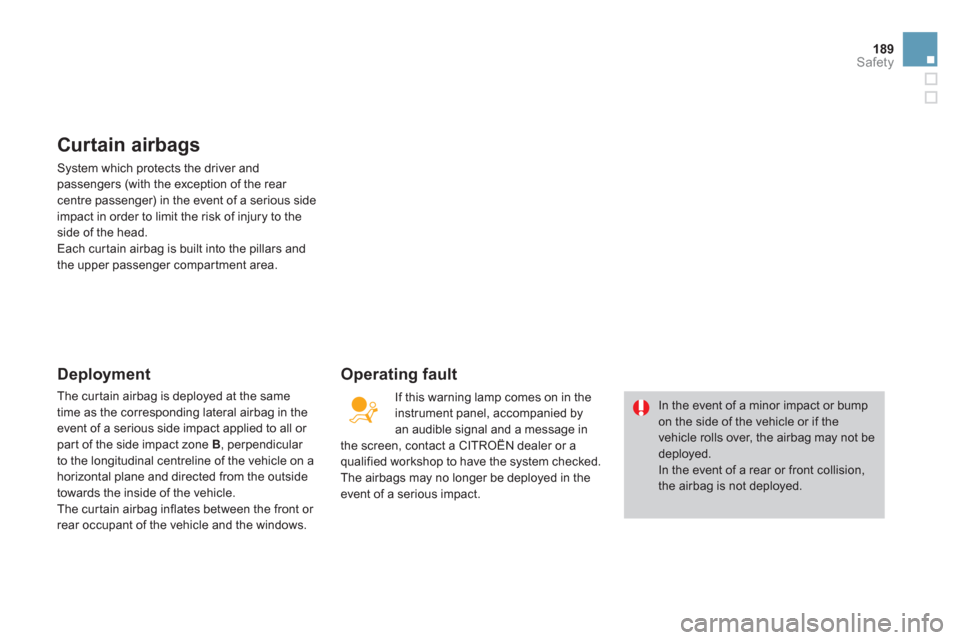
189Safety
Curtain airbags
System which protects the driver andpassengers (with the exception of the rear centre passenger) in the event of a serious side
impact in order to limit the risk of injury to theside of the head.
Each curtain airbag is built into the pillars andthe upper passenger compartment area.
Deployment
The cur tain airbag is deployed at the same
time as the corresponding lateral airbag in the event of a serious side impact applied to all or par t of the side impact zone B, perpendicular
to the longitudinal centreline of the vehicle on a horizontal plane and directed from the outside
towards the inside of the vehicle.
The cur tain airbag inflates between the front or
rear occupant of the vehicle and the windows.
Operating fault
In the event of a minor impact or bump on the side of the vehicle or if the vehicle rolls over, the airbag may not be deployed.
In the event of a rear or front collision, the airbag is not deployed.
I
f this warning lamp comes on in theinstrument panel, accompanied by
an audible signal and a message in
the screen, contact a CITROËN dealer or a
qualified workshop to have the system checked.
The airbags may no longer be deployed in the
event of a serious impact.
Page 192 of 396
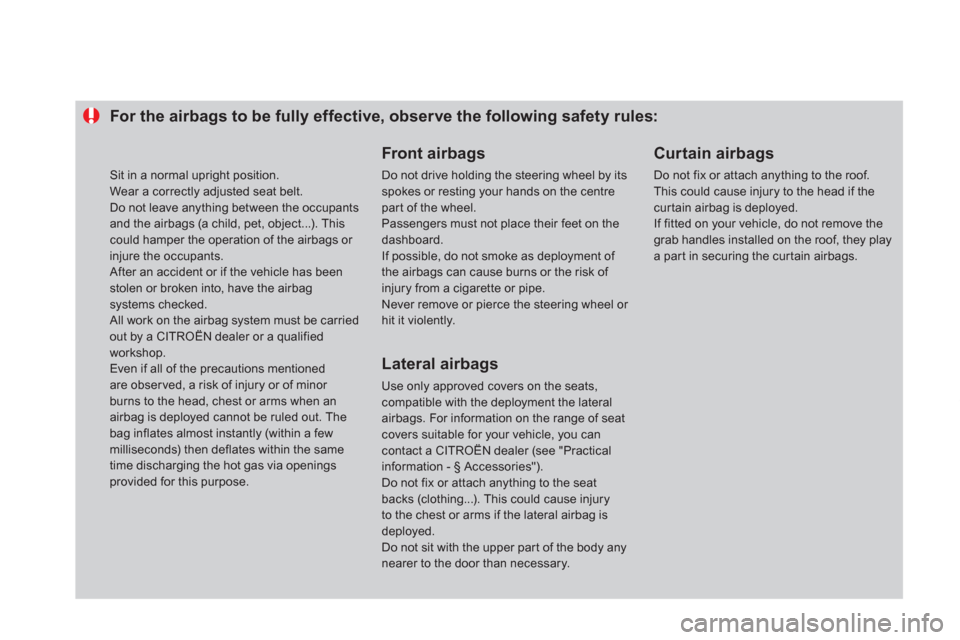
For the airbags to be fully effective, observe the following safety rules:
Front airbags
Do not drive holding the steering wheel by its spokes or resting your hands on the centre par t of the wheel.
Passengers must not place their feet on thedashboard.
If possible, do not smoke as deployment of the airbags can cause burns or the risk of injury from a cigarette or pipe.
Never remove or pierce the steering wheel or hit it violently.
Lateral airbags
Use only approved covers on the seats,compatible with the deployment the lateral airbags. For information on the range of seat covers suitable for your vehicle, you cancontact a CITROËN dealer (see "Practicalinformation - § Accessories").
Do not fix or attach anything to the seat backs (clothing...). This could cause injury to the chest or arms if the lateral airbag isdeployed.
Do not sit with the upper par t of the body any nearer to the door than necessary.
Curtain airbags
Do not fix or attach anything to the roof. This could cause injury to the head if thecurtain airbag is deployed.
If fitted on your vehicle, do not remove the grab handles installed on the roof, they play a par t in securing the cur tain airbags.
Sit in a normal upright position.
Wear a correctly adjusted seat belt.
Do not leave anything between the occupantsand the airbags (a child, pet, object...). This could hamper the operation of the airbags or injure the occupants. After an accident or if the vehicle has beenstolen or broken into, have the airbagsystems checked. All work on the airbag system must be carriedout by a CITROËN dealer or a qualified workshop.
Even if all of the precautions mentioned are obser ved, a risk of injury or of minor burns to the head, chest or arms when an airbag is deployed cannot be ruled out. The
bag inflates almost instantly (within a few milliseconds) then deflates within the sametime discharging the hot gas via openings provided for this purpose.
Page 193 of 396
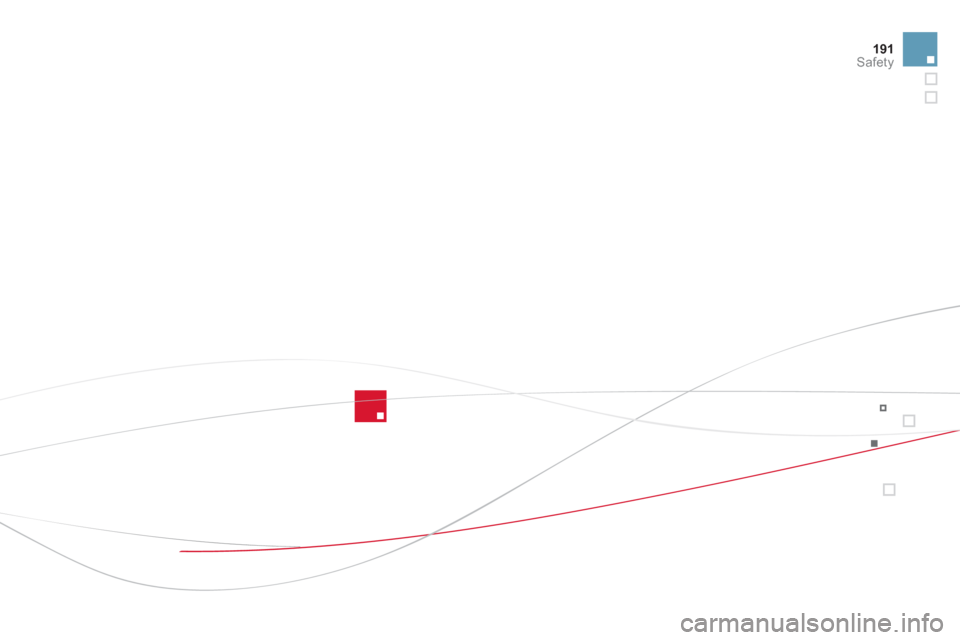
191Safety
Page 194 of 396
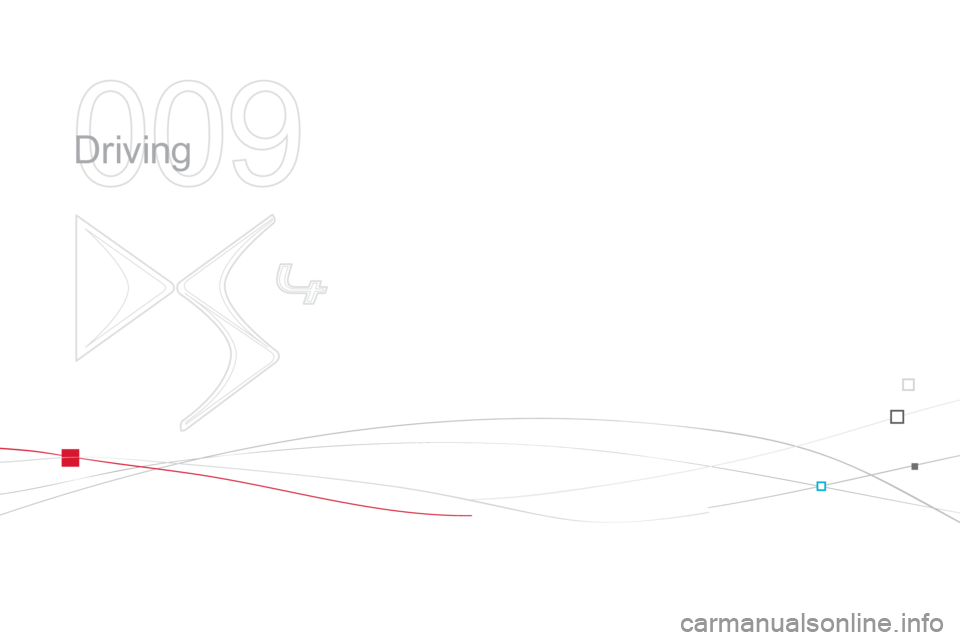
009
Driving
Page 195 of 396
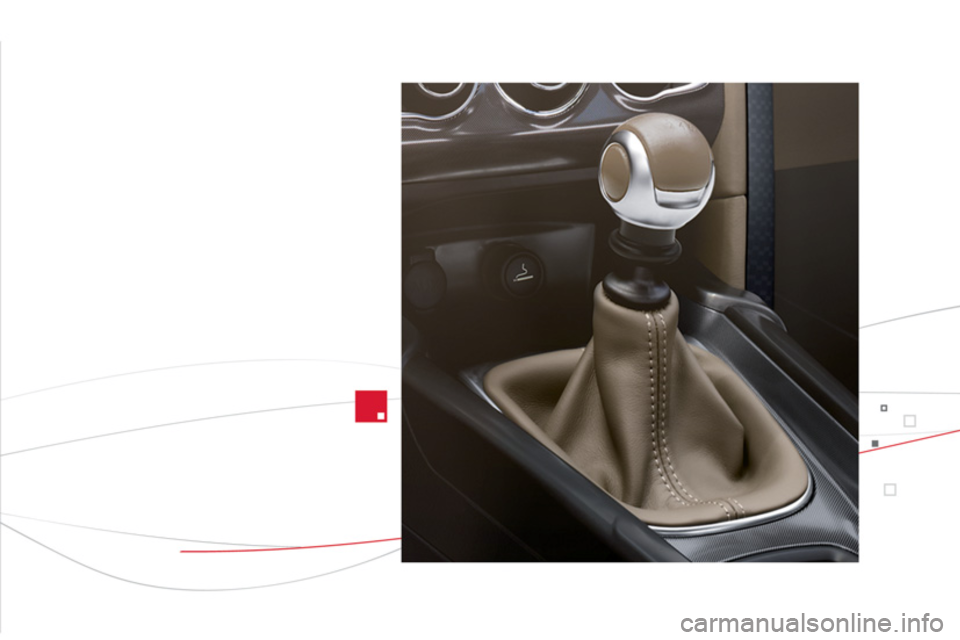
Page 196 of 396

Electric parking brake
The electric parking brake combines
2 operational modes:- Automatic Application/ReleaseApplication is automatic when the engine
stops, release is automatic on use of the
accelerator (activated by default),-Manual Application/ReleaseThe parking brake can be applied/releasedmanually by pulling control lever A.
Do not place any object (packet of cigarettes, telephone...) between thegear lever and the electric parkingbrake control lever.
It is recommended that you do notapply the parking brake in very coldconditions (ice) and during towing (breakdown, caravan...). Deactivate the automatic functions and release the parking brake manually.
If this warnin
g lamp comes on in
the instrument panel, the automatic
m
ode is deactivated.
Programming the mode
Depending on the country of sale of the vehicle,
the automatic application when the engine is
switched off and the automatic release whenyou press the accelerator can be deactivated.
Activation/deactivation is done
using the vehicle configurationmenu; refer to the section covering
the configuration of your vehicle'ssystems.
The parking brake is then applied and released
manually. When the driver's door is opened,
there is an audible si
gnal and a message is
displayed if the brake is not applied.
Page 197 of 396

195
Driving
With the ignition on or the engine running, torelease the parking brake, press on the brakepedalor the accelerator, pull then release
control A
.
Manual release
Before leaving the vehicle, ensurethat parking brake warning lamp inthe instrument panel is on fixed, not flashing.
Manual application
With the vehicle stationary, to apply the parkingbrake whether the engine is running or off, pullcontrol lever A.
The application of the parking brake is confirmed by:
- illumination o
f the braking warninglamp and of the P
warning lamp in
the control lever A,
- displa
y of the message"Handbrake on".
When the driver
’s door is opened with the engine running, a message is displayed
accompanied by an audible signal if the parkingbrake has not been applied, except in the case
of an automatic gearbox with the gear lever in position P.P
The full application of the parking brake is confirmed by:
- the brakin
g warning lamp and
the P warning lamp in the controllever Agoing off,
- displa
y of the message
"Handbrake off".
If you pull control lever Awithout pressingAthe brake pedal, the parking brake will not be released and a warning lamp willcome on in the instrument panel.
Maximum application
If necessary, you can make a maximum application
of the parking brake. This is obtained by means of a long pullon the control
l
ever A, until you see the message "Handbrake on maximum" and a beep is heard.
Maximum application is essential:
- in the case of a vehicle towing a caravan
or a trailer, if the automatic functions are
activated but you are applying the parkingbrake manually,
- when the gradient you are parked on may
vary (e.g. on a ferry, on a lorry, duringtowing).
In the case of towing, a loaded vehicle or parking on a gradient, make amaximum application of the parkingbrake then turn the front wheelstowards the pavement and engage agear when you park.
After a maximum application, the release time will be longer.
Page 198 of 396

With the vehicle stationary, the parking brake is automatically applied when the engine is
switched off.
Automatic application,
engine off
In the case of towing, a loaded vehicleor parking on a gradient, turn the front wheels towards the pavement and engage a gear when you park.
Before leaving the vehicle, ensurethat parking brake warning lamp inthe instrument panel is on fixed (notflashing). Never leave a child alone inside the vehicle with the ignition on, as they could release the parking brake.
- illumination o
f the braking warninglamp and of the P
warning lamp in
the control lever A ,
- displa
y of the message "Handbrake on". The application of the parkin
g brake is confirmed by:
Automatic release
The electric parking brake releasesautomatically and progressivelywhen youpress the accelerator:�)Manual gearbox:
press down fully on the clutch pedal, engage first gear or reverse,press on the accelerator pedal andmove off.�)6-speed electronic gearbox system:select position A
, M
or Rthen press on theaccelerator pedal. �)Automatic gearbox
: select position D, Mor Rthen press the accelerator pedal.
When stationary, with the engine running, donot press the accelerator pedal unnecessarily, as you may release the parking brake.
Full release of the parking brake is confirmed by:
- the brakin
g warning lamp and
the Pwarning lamp in the control lever A
going off,
- displa
y of the message"Handbrake off".
Page 199 of 396

197
Driving
With the engine running and the vehiclestationary, in order to immobilise the vehicleit is essential to manuallyapply the parking
brake by pulling
control lever A.
Immobilising the vehicle,
engine running
The emergency braking must only beused in exceptional circumstances.
Before leaving the vehicle, ensurethat parking brake warning lamp inthe instrument panel is on fixed, not flashing. The application of the parkin
g brake is confirmed by:
- illumination of the brakin
g
warning lamp and the Pwarning lamp in the control lever A ,
- displa
y of the message"Handbrake on".
When the driver’s door is opened, a messa
ge is
displa
yed accompanied by an audible signal, if
the parking brake has not been applied, except
in the case of an automatic gearbox with thegear lever in position P.P
Particular situations
In cer tain situations (e.g. star ting the engine),
the parking brake can automatically alter its force. This is normal operation.
To advance
your vehicle a few centimetres without star ting the engine, but with the ignition
on, press on the brake pedal and release the
parking brake by pulling
then releasing
the control lever A. The full release of the parkingbrake is confirmed by the warning lampsin the control lever A
and in the instrumentpanel going off and display of the message"Handbrake off".
If the parking brake develops a fault while appliedor if the battery runs flat, an
emergency release is always possible.
Emergency braking
In the event of failure of the electronicstability control system, signalled
by the illumination of this warning
lamp, braking stability is then not guaranteed.
In this event, stability must be assured by thedriver by repeating alternate "pull-release" actions on the control lever A.
In the event of a failure of the main servicebrake or in an exceptional situation (e.g. driver
taken ill, under instruction, etc) a continuous
pull on the control lever Awill stop the vehicle.
The electronic stability control provides stability
durin
g emergency braking.
If the emergency braking malfunctions,
the message "Parking brake faulty" will be
displayed.
Page 200 of 396

In the event of the electric parking brakemalfunctioning or the battery running flat, anemergency manual device can release theparking brake.�)Immobilise the vehicle (or keep it
stationary, if the brake pedal is pressed),
with the engine running, by engagingfirst gear (manual gearbox), position P(automatic gearbox) or position M or R(6 -speed electronic gearbox system).
Emergency release
�)
Switch off the engine but leave the ignition on. If it is not possible to immobilise the
vehicle, do not operate the control andcontact a CITROËN dealer or a qualified
workshop without delay.�) Fetch the two vehicle blocks B
and the
release device C, located under the boot carpet.
�)Immobilise the vehicle by placing the blocks
in front or behind the two front wheels,
opposite to the direction of the slope.�)Remove the storage box under the bootcarpet for access to the emergency releasedevice.